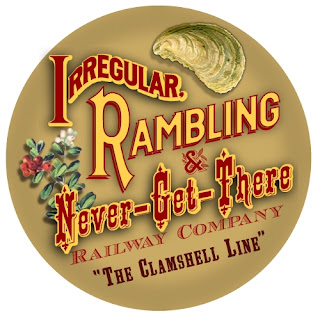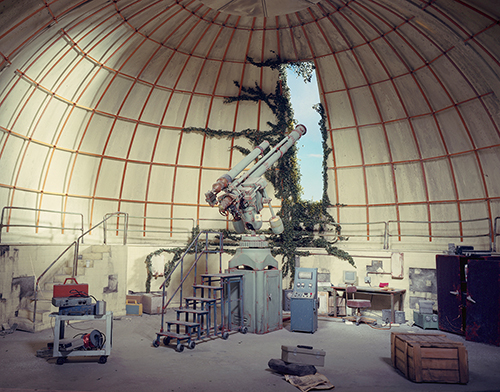To recap, I put three cardstock models in my bathroom and left them there for a week to see if the steam from showering would warp them.
I don't time my showers, but here's how they go -- I shower for about 10 or even 15 minutes, get out, open the bathroom door so the fog will clear from the mirror. I took six showers in that seven days and my wife used the tub to take one bath. (She has her own bathroom with just a shower, just in case you think she only bathed once this week). When I take a shower, the humidity on that shelf goes from about 65% to 85% -- yep, I measured it.
The first little model was an onion dome from the Tower of London. It didn't warp at all. (No photos, but just trust me.)
The second was a trackside beanery I built to the specifications of a client -- and his measurements were all wrong, so I didn't care if the model was ruined.
It wasn't. There's a tiny bend up and down along the doors and windows of the long side, but it's barely noticeable -- it would certainly pass inspection under the three foot rule. The short side looks fine. The roof, which isn't reinforced with trusses, also looks fine. I expect this very minimal amount of warping will even out when it fully dries.
Here's what I think goes on: the tabs and folded edges of the model act as reinforcements. The chipboard base and the roof serve the same function. The model might tend to warp along the direction of the grain of the cardstock, but the tabs and edges resist that tendency, and it all evens out.
On the second day of the test, I added the third model. It's been subjected to five showers worth of damp air.
It's not really a model, per se; it's just a bit of O-scale wall and a window that I built as a reference so I can see all the layers required to make a sash window. The wall is chipboard laminated with a cardstock printout. It did warp quite a bit.
Notice how it warped: side to side. This could be due to the differences in expansion between the thin cardstock and the thick chipboard. (That's why it's always best to laminate with a non-water-based glue.) I expect with a roof glued on, this side to side warping would have minimized. If I'd included a simple tab along the bottom or top, I think it would have remained straight. It remains to be seen whether it will flatten out when it dries. (UPDATE: It did.)
My conclusion is: a complete cardstock model that has a lot of tabs and folded edges will be fine.
Also, if your basement or layout room is so consistently damp that it could warp a cardstock model, I suspect you'll have even worse problems with mildew, or corrosion of electrical connections.
Saturday, April 25, 2015
Saturday, April 18, 2015
Testing a Hypothesis
I've decided to test a hypothesis that I've been hearing a lot from a client. He's an old-school model railroad guy, and he's really accepted the conventional wisdom that if you must build a structure from cardstock, it has to be reinforced with lots and lots of wooden strips inside, because moisture from the air will warp it.
Well, this is nonsense. I've got models I built ten or more years ago that show no warping at all, and I haven't taken any special care of them.
I'm going to test the far extreme of the conventional old-guy wisdom by setting two small cardstock models on a shelf in my bathroom for a week. Next Saturday, I'll take them out and see if they're still true and if the surfaces are still flat.
If they survive without warping at all, I'm going to consider the myth completely busted. I doubt that will be the case, but it would be nice.
If they warp, I'm going to see if they unwarp when they dry out -- that's really the result I expect. My hypothesis is, they'll almost certainly be fine in the long run, and possibly in the short run, because paper breathes. Under the extremes of the damp shower air, I expect the cardstock to
expand slightly, and then return to normal during the day. I could be wrong, but that's my guess, based on experience.
If I'm wrong and they become permanently warped, I'll agree that under extreme conditions, cardstock models will warp. But for the record, I've never had it happen under normal conditions.
LET THE TESTING BEGIN!
Wednesday, April 15, 2015
Current NYC Miniatures Exhibit
Feel Big Live Small at apexart (291 Church Street, Tribeca, Manhattan) through May 16.
Review and many photos here.
On a side note, I agree with the reviewer: "The sculpture (Super Lab Playset) reinforced my belief that LEGO, though it’s a fantastic toy and hobby, just does not work as a sculptural medium."
On a side note, I agree with the reviewer: "The sculpture (Super Lab Playset) reinforced my belief that LEGO, though it’s a fantastic toy and hobby, just does not work as a sculptural medium."
Tuesday, April 7, 2015
The Irregular, Rambling & Never-Get-There Railroad
This is my new favorite railroad: The Ilwaco Railway & Navigation Company, AKA "The Irregular, Rambling and Never-Get-There." It ran from the late 1880s to the 1930s along the Washington coast, carrying oysters, cranberries, and passengers. Like me, it was both whimsical and curmudgeonly -- it had a completely unreliable timetable based on the tides (which may be unique in railroad history), and the owner was so miserly he refused to replace ties unless he could punk a hole in them with his walking stick. The trains often stopped enroute for a plethora of bizarre and unpredictable reasons: so the passengers could shoot geese for dinner; to allow tourists to gawk at a beached whales and shipwrecks; or merely so a member of the crew could pick wildflowers for his wife. One woman dropped a ball of yarn out the window, and the engineer stopped the train, ran after it, and wound it up for her as he returned.
The owner had a private station in front of his mansion, and he frequently made trains wait for him, which threw the already capricious schedule off even further.
Without realizing it, I've eaten at a restaurant that was once a depot on this line, and I've driven through the tunnel that goes under Ft. Columbia many times while I lived in Astoria.

Friday, April 3, 2015
An O Scale Model of an HO Scale Model
I've been having problems wrapping my head around a convoluted layout for which I'm making structures. I emailed the guy who's doing the benchwork, and asked for an overhead plan of both decks of the whole thing. I printed them out in O scale, laminated the prints on chipboard, and built this model... of a model.
I used my label maker to print out all the town names, and glued them in place. Now I finally have a clear idea of where each town is, and how much room we have for structures!










